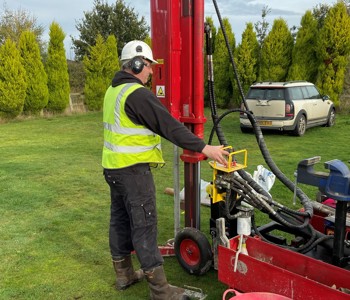What is Lab Testing, Soil, and Tree Root Identification?
At CTS, our UKAS-accredited* laboratories carry out lab testing, soil lab testing, and tree root identification, providing high-quality data that can be relied on.
By taking soil and root samples from a site and carrying out root and soil lab testing it allows us to see the soil classification and identify if a tree and its roots could be causing any problems with subsidence.

Tree Root Identification and Soil Lab Testing Services
Our soil lab testing and tree root identification services include: -
- Moisture content
- Atterberg limit tests
- Filter paper suction tests
- PSD (particle size distribution)
- Oedometer Swell/strain (Heave) tests to understand soil composition
Soil Lab Testing Processes
Moisture Content & PSD
Atterberg, moisture content tests, and PSDs are classification tests (index tests) to help us determine what the soil type is and the particle sizes.
Atterberg Limit Tests
Atterberg limit gives the plasticity index result. Soils tested within our soil lab testing facilities with a plasticity index below 20% are regarded as having low shrink-swell potentials, whilst those between 20-40% are classed as medium, and anything above is classed as high.
Filter Paper Suction Tests
Filter paper suction tests are used to determine the degree of potential desiccation. The stronger the desiccations, the drier the sample can be which leads to cracking and voids within the ground.
Oedometer Swell/Strain
The swell strain tests (Oedometer), test the swell of soil when subjected to moisture. Swell is the volume change that occurs as a result of changes in the moisture content of clay-rich soils during soil lab testing. Swelling pressures can cause heave,/lifting of structures, whilst shrinkage can cause settlement/ subsidence.
Suctions and swells
A swell strain test is done by applying a load to a sample in our soil lab testing facility to attempt to simulate the pressures and conditions that the material would be under within the ground. Then while maintaining those conditions, giving the material full access to water, just as if dry ground on location was fully saturated with rain.
This allows the material to take in any water during the soil lab testing to reach a natural equilibrium point and allows for the measurement of any increase in height (swelling) or decrease in height (consolidation/collapse) that occurs as the water is taken in, while the material moves towards this equilibrium point. The recorded swell/collapse from the test can be taken as an approximate representation of what could occur in the material on location if it gains access to its natural “ideal” amount of water through the ground returning to full saturation.
- The filter paper test estimates clay material desiccation based on voids between particles that hold water and pressure.
- As the clay dries void pressure decreases due to water evaporation or suction like from tree roots causing negative pressure.
- In soil lab testing, known filter papers contact the clay to reach an equilibrium where clay void suction matches paper suction.
- Using filter paper calibration values, absorbed water calculates paper suction equivalent to clay void suction.
- Multiple tests over an area like around a tree create a profile to determine increased desiccation proximity to the tree, indicating disturbance.
Why Choose CTS for Lab Testing, Soil and Tree Root Identification?
At CTS our expert team of UKAS-accredited technicians and engineers offer a wide and comprehensive range of tree root identification and soil lab testing services nationwide providing reliable and accurate testing and reports.
To find out more about our soil lab testing services, please get in touch with a member of the CTS team today, and we’ll be more than happy to answer any questions you may have regarding our services and how we can help you.
Our Other Site Investigation Services:
Request a Quote
Frequently Asked Questions
Do tree roots cause subsidence?
Tree roots can cause subsidence when they are present in clay soil, as this will shrink when the roots take away moisture. This can cause any foundation or structure built on the clay to subside.
How do you prove a tree is causing subsidence?
Root samples can be taken from either a trial pit or a borehole. These are then tested to identify the species of tree they originated from. This information is then compared to an arboricultural report of nearby trees to identify the problem tree or trees.
What soil testing help determine subsidence?
The main laboratory soil tests that help determine subsidence are moisture content, Atterberg’s, soil suction and Oedometer.
* To view our full UKAS schedule visit here.




